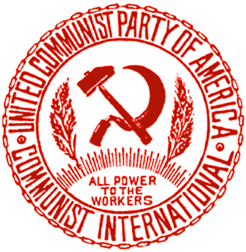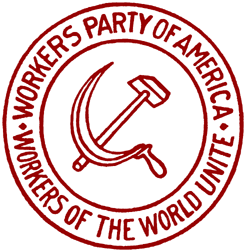Armenian group of the United Communist Party
In December of 1920 there was but a single primary party unit ("Group") in the United Communist Party using the Armenian language, located in New York City.
[fn: DoJ/BoI Investigative Files, NARA M-1085, reel 940, doc. 501 — downloadable below.]
Armenian Section of the Workers Party of America
There was a factional division among the Armenian workers sympathetic to the Comintern in the early 1920s. Two organizations competed with each other, the Armenian Workers Party and the former Social Democratic Hunchakist Party.
On December 27, 1923, the battle between these two organizations for the mantle of the CI was taken up by the Executive Committee of the Comintern, which adopted a resolution demanding that Comrade Sunarin and his group which had bolted the Workers Party return to party ranks. An Armenian Conference was additionally to be carried out following the convocation of the WPA’s 3rd Convention at the end of December 1923. This conference was to definitely form the Armenian Section of the Workers Party.
The CEC of the WPA set Feb. 22, 1924 as the date and Boston the locale for the convention to form the Armenian Section of the WPA. The Armenian section would be the 18th language group of the WPA.
The Armenian Federation of the Workers Party had branches in New York; Los Angeles; San Francisco; Chicago; Detroit; Boston; East Boston; Worcester, MA; Watertown, MA; Toledo, OH; Hopewell, VA; Providence, RI; Ambridge, PA; Lawrence, MA, Granite City, IL; and Indiana Harbor, IN.
1. Unity Convention —- Boston, MA —- Feb. 22, 1924.
Therer were a total of 38 delegates to the Unity Convention — 19 delegates from 16 branches of the “Armenian Federation of the Workers Party, Social Democratic Huntchakist”and 19 delegates from 16 branches of the Armenian Workers Party, which had not been affiliated with the WPA prior to the convention.
The unity program was proposed by C.E. Ruthenberg, who represented the WPA at the convention. Provisions of the agreeement called for recognition of both groups and issuance of membership cards and dues stamps to both groups; a requirement that within 3 months the branches of the two groups would merge into a single organization, with one branch in each city; a requirement that a Bureau be elected by each of the groups under condition of a prohibition of factional activity, including letters and circulars. At the end of the 3 month period, the CEC of the WPA was to either appoint a Bureau to represent the United Armenian Section or call an new convention. Branches or individuals failing to carry out or hindering execution of the unity program were to be subject to expulsion from the WPA.
1920
DECEMBER
“United Communist Party — “Groups" According to Language: As of December 1920.”This is based upon an internal document of the United Communist Party captured by the Department of Justice’s Bureau of Investigation in the April 1921 raid on UCP National Headquarters in New York. The UCP prided itself on having largely eliminated the federation-based form of organization which typified its rival, the Communist Party of America. Groups (Primary Party Units of between 5 and 10 members) were nevertheless based around language as well as geography and statistics tabulated by the organization. This snapshot from the midpoint of the UCP’s one year of existence surprisingly shows more South Slavic (Croatian and Slovenian) language groups than any other (144), followed by the Russian (136), English (121), German (61), Latvian (49), Yiddish (37), Lithuanian (34), and Finnish (31) language groups.
undetermined date
“Membership Series by Language Federation for the Workers Party of America. ‘Dues Actually Paid’ — January to December 1923.”Official 1923 data set of the Workers Party of America, compiled from a document in the Comintern Archive. This series shows a great numerical dominance of the WPA by its Finnish Federation, accounting for a massive 42.8% of the average monthly paid membership of the organization (6,583 of 15,395). The total of the English language branches is the 2nd strongest amongst the federations (7.6%) followed by the South Slavic (7.5%), Jewish [Yiddish language] (6.9%), and Lithuanian (6.0%) Federations. In all, there were statistics kept for 18 different language groups of the WPA in 1923, including the English and the barely organized Armenian sections.
Initiation Stamps Sold by Federation for the Workers Party of America. January to December 1923. Official 1923 data set of the Workers Party of America, compiled from a document in the Comintern Archive. This series once again (repeating the previous published 1924 series) shows a schizophrenic pattern of stamp sales among language groups . Some federations clearly did not collect the initiation fees called for in the WPA constitution at all (Jewish, German, Latvian) while at the same time the quantities sold via the English branches are ridiculously high. Over 53% of the initiation stamps sold for the entire WPA were credited to the English branches — nearly three times as many initiations than there were average duespayers in those English branches! Even assuming a significantly higher than average “membership churn”rate for English branches, there is clearly some other unexplained phenomenon at play in these English branch initiation stamp sale figures...
undetermined date
“Membership Series by Language Federation for the Workers Party of America. ‘Dues Actually Paid’ — January to December 1924.”Official 1924 data set of the Workers Party of America, compiled from a document in the Comintern Archive. This shows a continued numerical dominance of the Workers Party of America by its Finnish-language federation, averaging a paid membership of 7100 (41% of the entire organization) for the year 1924. Impressive growth is shown by the Yiddish-language ("Jewish") federation, which moved to the third largest language group in the WPA in 1924. The English branches comprised the second largest language group in the WPA, but still remained just 11% of the overall organization. The South Slavic federation (predominately Slovenian and Croation) was the 4th largest language group in the WPA, topping the Russian, Lithuanian, and Ukrainian federations.
“Initiation Stamps Sold by Federation for the Workers Party of America. January to December 1924.”Official 1924 data set of the Workers Party of America, compiled from a document in the Comintern Archive. An extremely interesting monthly series in which two unexplained anomalies are apparent: (1) The failure of at least 8 of the WPA’s 18 language sections to make more than a token effort to collect the $1 initiation fee and obvious similar behavior (to lesser degree) among branches of other language groups; (2) A preposterously large sale of 5,264 initiation stamps to “English”branches, which averaged a paid membership of just 1909 over the course of the year. Either there was a revolving door in the English branches that was entirely dissimilar to the situation in any other language group of the WPA; or there was some sort of effort to collect initiation fees among “English”workers without organizational follow up; or there was some sort of strange accounting practice used by the WPA in which miscellaneous sales of initiation stamps were lumped into the “English”category (or some combination of these explanations). A perplexing question in raised, with further archival research clearly necessary.


